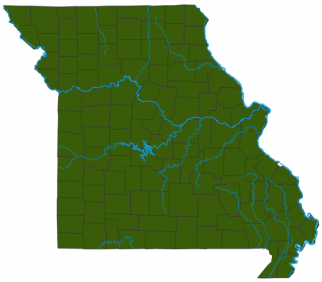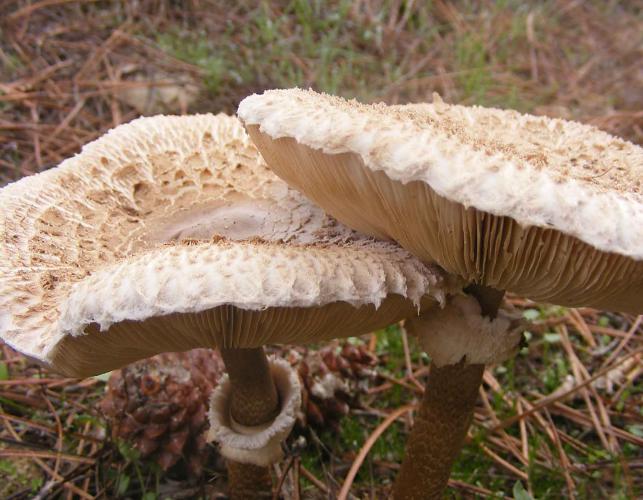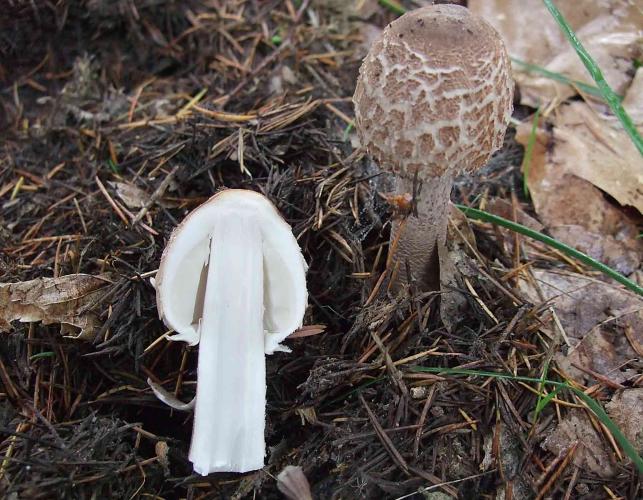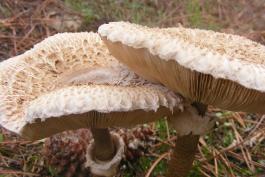
Very tall; cap buff to brown, broad, scaly, with a knob in center; moveable ring on stalk. Grows scattered on ground, along trails, in open woods, and in old pastures. June–October. Cap egg-shaped, becoming flat with a definite knob in the center; pale buff to grayish brown, covered with darker brown, shaggy scales; texture scaly. Gills broad; spacing close; white, darkening with age; attachment free. Stalk tall and slender, with a bulbous base; whitish, with small brownish scales; texture scaly; has a ring on the upper part. Partial veil leaving a white, loose, skirtlike ring on the upper stalk. Spore print white. Spores magnified are very large, broadly elliptical, colorless, with a pore at the tip. Look for the moveable fringed ring on the parasol's long stalk.
Lookalikes: Green-spored lepiota (Chlorophyllum molybdites) has white gills that turn grayish or greenish with age, and a greenish spore print. Reddening lepiota (Leucoagaricus americanus) bruises and ages red.
Cap width: 3–8 inches; stalk length: 5–16 inches; stalk width: ¼–¾ inch.

Statewide.
Habitat and Conservation
Grows scattered on the ground, along trails, in open woods, and in old pastures, sometimes in arcs or circular "fairy rings."
Status
Considered a choice edible — with caution. Don’t confuse this with the poisonous green-spored lepiota. Take a spore print before eating.
Life Cycle
This species exists most of the time as a network of fungal cells (mycelium) in the soil, digesting and decomposing organic matter. It grows outward from a central point. Because the most active parts of the mycelium are on the outer edge, mushrooms can appear in arcs or circular "fairy rings." When ready to reproduce, the mycelium develops mushrooms, whose purpose is to produce and spread spores. The mycelium of a mushroom can live for decades.
Human Connections
Humans have eaten mushrooms for thousands of years, in many cultures, for various purposes. Sometimes they are eaten for their nutritional and culinary value; sometimes they are considered medicinal. Be absolutely sure of your identifications before you consume wild mushrooms!
Ecosystem Connections
This is one of the many fungus species that live on decaying plant materials. It and other such saprobic fungi play an incredibly important role in breaking down the tough materials plants are made of and returning those nutrients to the soil.






Mushrooms are a lot like plants, but they lack chlorophyll and have to take nutrients from other materials. Mushrooms are neither plants nor animals. They are in a different kingdom — the fungi. Fungi include the familiar mushroom-forming species, plus the yeasts, molds, smuts, and rusts.
Always be cautious when eating edible mushrooms. Be absolutely sure of the ID, and only eat a small amount the first time you try it to avoid a reaction..





















